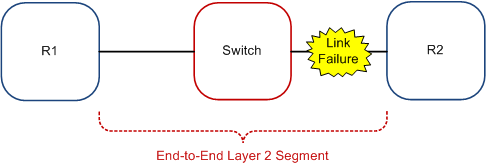Many networks today are striving for “five nines” high availability and beyond. What this means is that network operators must configure the network to detect and respond to network failures as quickly as possible, preferably on the order of milliseconds. This is in contrast to the failure detection inherent in most routing protocols, which is typically on the order of several seconds or more. For example, the default hold-time for BGP in JUNOS is 90 seconds, which means that in certain scenarios BGP will have to wait for upwards of 90 seconds before a failure is detected, during which time a large percentage of traffic may be blackholed. It is only after the failure is detected that BGP can reconverge on a new best path.
Another example is OSPF which has a default dead interval of 40 seconds, or IS-IS which has a default hold-time of 9 seconds (for DIS routers), and 27 seconds (for non-DIS routers). For many environments which support mission-critical data, or those supporting Voice/Video or any real-time applications, any type of failure which isn’t detected in the sub-millisecond range is too long.
While it is possible to lower timers in OSPF or IS-IS to such an extent that a failure between two neighbors can be detected rather quickly (~1 second), it comes at a cost of increased protocol state and considerable burden on the Routing Engine’s CPU. As an example, let us consider the situation in which a router has several hundred neighbors. Maintaining subsecond Hello messages for all of these neighbors will dramatically increase the amount of work that the Routing Engine must perform. Therefore, it is a widely accepted view that a reduction in IGP timers is not the overall best solution to solve the problem of fast failure detection.
Another reason that adjusting protocol timers is not the best solution is that there are many protocols which don’t support a reduction of timers to such an extent that fast failure detection can be realized. For example, the minimum BGP holdtime is 20 seconds, which means that the best an operator can hope for is a bare minimum of 20 seconds for failure detection.
Notwithstanding, this does nothing about situations in which there is no protocol at all, for example, Ethernet environments in which two nodes are connected via a switch as can be seen in the figure below. In this type of environment, R1 has no idea that R2 is not reachable, since R1’s local Ethernet segment connected to the switch remains up. Therefore, R1 can’t rely on an ‘Interface Down’ event to trigger reconvergence on a new path and instead must wait for higher layer protocol timers to age out before determining that the neighbor is not reachable. (Note to the astute reader: Yes, Ethernet OAM is certainly one way to deal with this situation, but that is a discussion which is beyond the scope of this article).

Essentially, at the root of the problem is either a lack of suitable protocols for fast failure detection of lower layers, or worse, no protocol at all. The solution to this was the development of Bidirectional Forwarding Detection, or BFD, developed jointly by Cisco and Juniper. It has been widely deployed and is continuing to gain widespread acceptance, with more and more protocols being adapted to use BFD for fast failure detection.
So what is the Big Freaking Deal with Bidirectional Forwarding Detection anyway and why are so many operators implementing it in their networks? BFD is a simplistic hello protocol with the express purpose of rapidly detecting failures at lower layers. The developers wanted to create a low overhead mechanism for exchanging hellos between two neighbors without all the nonessential bits which are typical in an IGP hello or BGP Keepalives. Furthermore, the method developed had to be able to quickly detect faults in the Bidirectional path between two neighbors in the forwarding plane. Originally, BFD was developed to provide a simple mechanism to be used on Ethernet links, as in the example above, prior to the development of Ethernet OAM capabilities. Hence, BFD was developed with this express purpose in mind with the intent of providing fault identification in an end-to-end path between two neighbors.
Once BFD was developed, the protocol designers quickly found that it could be used for numerous applications beyond simply Ethernet. In fact, one of the main benefits of BFD is that it provides a common method to provide for failure detection for a large number of protocols, allowing a singular, centralized method which can be reused. In other words, let routing protocols do what they do best – exchange routing information and recalculate routing tables as necessary, but not perform identification of faults at lower layers. An offshoot of this is that it allows network operators to actually configure higher protocol timer values for their IGPs, further reducing the burden placed on the Routing Engine.
BFD timers can be tuned such that failure detection can be realized in just a few milliseconds, allowing for failure and reconvergence to take place in similar timeframes to that of SONET Automatic Protection Switching. A word of caution – while BFD can dramatically decrease the time it takes to detect a failure, operators should be careful when setting the intervals too low. Very aggressive BFD timers could cause a link to be declared down even when there is only a slight variance in the link quality, which could cause flapping and other disastrous behavior to ensue. The best current practice with regards to BFD timers is to set a transmit and receive interval of 300ms and a multiplier of 3, which equates to 900ms for failure detection. This is generally considered fine for most environments, and only the most stringent of environments should need to set their timers more aggressive than this.
One question that is commonly asked is how is it that BFD can send hello packets in the millisecond range without becoming a burden on the router. The answer to this question lies in the fact that BFD was intended to be lightweight and run in the forwarding plane, as opposed to the control plane (as is the case with routing protocols). It is true that while early implementations of BFD ran on the control plane, most of the newer implementations run in the forwarding plane, taking advantage of the dedicated processors built into the forwarding plane and alleviating the burden which would otherwise be place on the RE. In JUNOS releases prior to JUNOS 9.4, BFD Hello packets were generated via RPD running on the RE. In order to enable BFD to operate in the PFE in JUNOS versions prior to JUNOS 9.4, the Periodic Packet Management Daemon (PPMD) had to be enabled, using the command ‘set routing-options ppm delegate processing’. In JUNOS 9.4 and higher this is the default behavior and BFD Hello packets are automatically handled by PPMD operating within the PFE.


 IS-IS: Deployment in IP Networks
IS-IS: Deployment in IP Networks